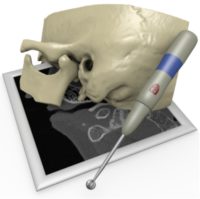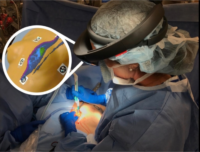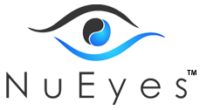Medical VR and AR – Demos
Curated by Lily Achatz, Executive Producer at Light Field Interactive

CardinalSim is an immersive simulation environment developed for the preoperative rehearsal of complex surgical procedures.
With CardinalSim, a user creates surgical scenes in which anatomic structures are derived from segmented clinical PACS systems.
Volumetric structures may be represented with predefined or customized material properties and viewed with a variety of stereoscopic displays using real-time volumetric rendering.
Virtual dissections can be performed with the support of high-fidelity haptic feedback from a variety of supported hardware. The dissections can be compared with intraoperative video for retrospective analysis.

The Stanford Virtual Heart experience helps families understand their child’s heart conditions by employing a new kind of interactive visualization that goes far beyond diagrams, plastic models and hand-drawn sketches. For medical trainees, it provides an immersive and engaging new way to learn about the two dozen most common and complex congenital heart anomalies by allowing them to inspect and manipulate the affected heart, walk around inside it to see how the blood is flowing, and watch how a particular defect interferes with the heart’s normal function.

The CHARIOT (Childhood Anxiety Reduction through Innovation and Technology) Program at Lucile Packard Children's Hospital Stanford knows that undergoing surgery, anesthesia and procedures can be especially stressful for children. CHARIOT's mission is to implement technologies that are not traditionally in the hospital to engage and distract children during these during these times. The CHARIOT Program creates advanced experiences to provide a patients a toolbox of immersivity, tailored to the unique needs of individual patients. The Program utilizes portable and stationary VR, AR, and smart projectors, which have now been deployed in multiple departments and clinics through Stanford Children's Health.

IMMERS is the Incubator for Medical Mixed and Extended Reality at Stanford. The goal of Medical Mixed Reality is to improve patient care by fusing a patient’s images with their body, enabling physicians to look inside them, to see anatomy, function and disease in its actual location, thereby improving diagnosis, disease assessment, treatment planning and procedure guidance. IMMERS is a place to bring thought-leading physicians, engineers and scientists together to rapidly iterate proof-of-concept (POC) solutions for specific medical needs. Current applications include mixed reality breast surgery, augmented reality ultrasound scanning and neuronavigation.

The incidence of autism spectrum disorder (ASD) has increased dramatically in the past few decades to 1 in 68 children, overburdening clinicians and creating waiting periods of several months or even years for a clinical diagnosis and access to therapy. Autism Glass provides a mobile therapy platform that automatically detects facial expressions and provides instantaneous social cues via smart glasses to people with autism in their natural environment. Through a dedicated app, caregivers can then review and discuss auto-curated videos of social interaction captured throughout the day. This brings therapy into the homes of families who otherwise may face long waitlists or have no access to treatment, enabling caregivers to deliver scalable therapy that generalizes learned skills into everyday life.

Using patient specific scans see how Surgeons today are Pre Planning, Navigating, and Collaborating in 360 Degree Virtual Reality.
The Surgical Planner accesses files from a patient’s traditional image modalities, such as CT or MRI scans, and processes the information to create patient-specific, VR reconstructions to help a neurosurgeon plan surgery, and educate the patient about their neurological condition.
The interactive, immersive reconstruction can be seen on a touchscreen and through the use of a VR headset, such as Oculus Rift® or HTC Vive®.
Surgeons can fly through the brain and locate medical issues such as a tumor or an aneurysm and study it from every angle with our medical virtual reality services.

Synaptive partners with healthcare teams to understand the challenges they face both in the operating room and across the hospital. We designed our Brightmatter™ product suite to unite surgical planning and navigation, robotic automation, digital microscopy and informatics through a uniquely interconnected, fully integrated platform.

SimX makes virtual and augmented reality medical simulation products. SimX's VR simulation platform allows you to place a virtual patient onto any empty hospital bed, table, or your desk at home and run fully featured medical simulation cases. The platform is completely wireless, multiplayer, collaborative, cross-platform, flexible and designed for educators. It can be used for teaching MAs to check vitals all the way up to training attending physicians with multiple simultaneous resuscitations.

OSSO VR is the leading, validated virtual reality surgical training platform designed for surgeons, sales teams, and hospital staff of all skill levels. Our product offers highly realistic hand-based interactions in an immersive training environments that contain the latest, cutting edge procedures and technology.

Context aware augmented reality for surgeons: In critical care environments, Doctors and first responders can focus on stabilizing their patient’s condition while relevant information is pushed to the smart glasses wearable device.

The Olympus Eye Trek INSIGHT EI-10 smart glasses is a compact lightweight wearable device that can capture and display information. The EyeTrek INSIGHT’s intuitive interface allows you to control apps and the camera with a simple swipe or tap on the Touch Sensor Bar. Headset / microphone accessory can be used for applications utilizing verbal communication. The EI-10 runs on Android and includes a robust array of development tools that can be used to customize applications.
ODG, the world leader in fully integrated Smartglasses perfect for Visualization, Training, Procedure Guidance, Remote Assistance and Virtual Consults. Take an early look at ODG's R-9 Smartglasses, providing the highest image quality available on a see-through display, including the fastest onboard processing and advanced sensors. Demos include a novel medical visualization experience which utilizes inside out Six Degrees of Freedom Tracking enabling the user to explore content with a hands free interface.

Wearable technology is the future and NuEyes featuring ODG Smartglasses brings the future to you in a small, compact yet powerful head worn device.
NuEyes makes it possible for those with visual impairments to connect with loved ones and others without always having to use a big clunky machine. Our removable visual prosthetic helps the visually impaired see again while keeping their hands free.

AMA XpertEye is a hands free, mobile, see what I see collaboration solution using smart glasses. It enables a glasses wearer to share their vision with a remote observer located anywhere in the world. Our solution was the first to be utilized during a live surgery across different countries, between teams in France and Japan. Recently an NGO called Mending Kids has been utilizing our solution to help train doctors in developing nations by pairing them with specialists located across the US and Europe. Xpert Eye’s key differentiator is its ability to operate over low bandwidth using either a mobile or Wi-Fi connection.

Vivid Vision, Inc. is a virtual reality software company with offices in San Francisco and Tokyo. The company specializes in eye care products for optometrists, ophthalmologists, and orthoptists to treat patients with amblyopia, strabismus, and other disorders of binocular vision, and to do visual field testing. The system comes on two platforms: PC-based for in-office use, and mobile for use anywhere. The mobile platform makes reliable perimetry easy, portable, and inexpensive and thus ideal for screening or for monitoring glaucoma at home. Vivid Vision is used in more than 100 clinics in the North America, Europe, Asia, and Australia.

Firsthand Technology is the industry leader in Virtual Reality for healthcare bringing products to leading medical institutions today. Our evidence-based approach maximizes VR’s high-bandwidth channel to the brain to deliver adaptive, clinically validated solutions for a wide range of health conditions, improve recovery, and reduce the use of opioids.
